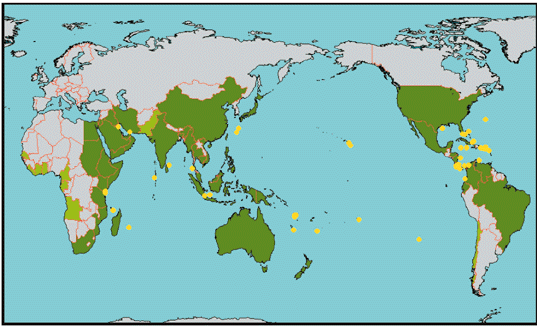TOP STORIES ISU researchers seek clues to why Wyoming toads are disease resistant
ISU researchers seek clues to why Wyoming toads are disease resistant
Idaho State University - www2.isu/edu
26 Jun 2008
Area: United States
To croak or not to croak, both literally and figuratively, is the question. Boreal toad populations have declined severely in Colorado, but not in western Wyoming or Montana. Idaho State University researchers are trying to help determine why this is happening. They’re tracking these nocturnal animals by using tiny radiotransmitters attached to the amphibians, to record their movement, temperature and habitat use. Researchers are resorting to these methods because die-offs of the southern populations of the boreal toad (Bufo boreas boreas), including those from southeast Wyoming, Colorado and New Mexico, have been so severe that they were considered a candidate for listing under the U.S. Endangered Species Act (ESA).
 Satellite finds coral-killing hot spots
Satellite finds coral-killing hot spotsScienceAlert - www.sciencealert.com.au (Source: University of Queensland)
26 Jun 2008
Image courtesy of marinebiology.org
Killer hotspots of over-heated ocean water which destroy huge areas of coral and bring starvation to birds, fish and other sea creatures can now be pinpointed, thanks to a major advance in the use of satellite technology by Australian and American researchers working under the Marine and Tropical Sciences Research Facility (MTSRF) program. Advanced satellites and smart mathematics are enabling the scientists to detect the events which cause mass bleaching of corals and disruption of marine food chains with unprecedented precision. This is revealing the Great Barrier Reef's most threatened areas under global warming. “Until now we have only been able to detect large-scale events under typical seasonal conditions," MTSRF team leader and University of Queensland (UQ) researcher Dr Scarla Weeks said.
Cited Journal Article
>>>Improved predictions of coral bleaching using seasonal baselines and higher spatial resolution. Limnol. Oceanogr. 2008 Jul; 53(4): 1369–1375.
 New England moose under attack from ticks
New England moose under attack from ticksSeacoastonline.com - www.seacoastonline.com (Source: Associated Press)
24 Jun 2008
Image courtesy of Wikipedia
Area: New England United States
. . . In 1992, an estimated 20 percent of New Hampshire's moose herd had at least some hair scraped off because of ticks. Close to 100 percent do now, said Kristine Rines, moose project leader for the New Hampshire Department of Fish and Game. The ticks take the hardest toll on moose going through their first winter without the fat and protein reserves of adults. In the worst of years, New Hampshire's north country has lost close to 70 percent of its calf crop to winter ticks and about 20 percent of the adults, Rines said. Ticks may be keeping the state's herd size at about 6,000. "The population has not grown at the rate that we would expect," she said.
 Research affirms Tb strategy
Research affirms Tb strategyOtago Daily Times - www.odt.co.nz
27 Jun 2008
N Wallace
Image courtesy of feral.org.au
Area: New Zealand
Targeting possums to stop the spread of bovine tuberculosis is the right thing to do, new research has shown. Landcare Researchers have confirmed that ferrets and pigs have little or no role in spreading the disease, but were end hosts. Ivor Yockney, from Lincoln, told the recent Federated Farmers High Country committee conference that research on Molesworth Station tried to determine the roles of pigs and ferrets in spreading the disease. It confirmed they were the end hosts and that possums remained the main culprit. Mr Yockney said the research looked at the relationship between habitat, altitude, wildlife and possum numbers, the seasonal movement of ferrets and possums, the prevalence of Tb in pigs, ferrets and possums, the status of pigs in spreading the disease and identifying priority areas for vector control.
OTHER WILDLIFE HEALTH RELATED NEWS
Image courtesy of www.wildlifeextra.com







No comments:
Post a Comment